| Release List | Reviews | Price Search | Shop | Newsletter | Forum | DVD Giveaways | Blu-Ray/ HD DVD | Advertise |
| Reviews & Columns |
|
Reviews DVD TV on DVD Blu-ray International DVDs Theatrical Reviews by Studio Video Games Features Collector Series DVDs Easter Egg Database Interviews DVD Talk TV DVD Talk Radio Feature Articles Columns Anime Talk DVD Savant HD Talk Horror DVDs Silent DVD
|
DVD Talk Forum |
|
|
| Resources |
|
DVD Price Search Customer Service #'s RCE Info Links |
|
Columns
|
 |
Warner Bros. Pictures Tough Guys Collection |
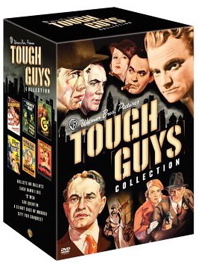
B&W 1:37 flat full frame Street Date July 18, 2006 59.98 the boxed set Available separately at 19.98 Reviewed by Glenn Erickson |
Summer's here, and Warner Home Video is favoring us with a double kicker release of crime and mystery-oriented thrillers. a Film Noir 3 collection continues the surprise 2004 success of one of the first Warners boxed sets to be organized around a theme and not a personality. This gutsy assortment of Tough Guy pictures appears to be a continuation of last year's thrilling Warner Gangsters Collection. The name change was probably suggested by historical necessity. After the first flurry of controversial gangster movies, the new Production Code made its first priority the complete eradication of the gangster-as-hero theme.
The boxed set stacks up this way: Two transition pictures that find an excuse to show gangland violence and thrills without glamorizing the criminal, along with genre hybrids that graft comedy and social relevance onto once-gritty film material. And the collection ends up with a salute to James Cagney, transformed from cheap hood to transcendent "good guy of the streets" in the bizarrely affecting City for Conquest, which I've reviewed separately to give it special consideration.
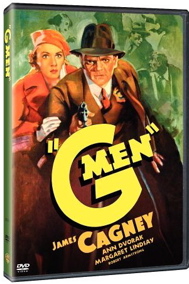
'G' Men
1935 / 85 min. /
Starring James Cagney, Margaret Lindsay, Ann Dvorak, Robert Armstrong, Barton MacLane, Lloyd Nolan
Cinematography Sol Polito
Art Direction John Hughes
Film Editor Jack Killifer
Written by Seton I. Miller from a novel by Darryl F. Zanuck
Produced by Louis F. Edelman
Directed by William Keighley
First up is a rip-roaring thriller that's been dissected in every analysis of the gangster genre. Cagney returns in a storyline chock-full of supposedly no-no gangster content: Murders, daring robberies, shoot-outs with the cops. Some of the events pictured are based on real headlines -- the death of a federal agent while transporting a prisoner, the famous Little Bohemia gun battle that involved John Dillinger and Baby Face Nelson. How could all of this gangster violence reach the screen a year after the stringent Production Code went into effect? The hero is a Government agent, a "G-Man," so all of the action is "moral." The whole movie is a promotional piece for the new Federal Bureau of Investigation.
In 'G' Men we get a massive dose of the same forbidden action seen in the reviled Scarface, Shame of a Nation, only with more violence! The tautly written picture plays like a recruiting ad for the FBI, with Cagney using his considerable street-wise skills to make Brick Davis a crime fighter par excellence.
The story is enjoyable hokum. Cagney holds up well under hazing during training, and grins with supreme self-confidence as Margaret Linsday (later of Jezebel) gives him her coldest shoulder. Cagney is an unbeatable combination of humility and cheeky nerve, a die-hard man of action who makes Government cop work look like a picnic.
The story has no doubts whatsoever about whom the good guys are. Even if they reform, all the gangsters end up eating asphalt, and our unlikely hero (raised and educated with mob money, but still pure) might as well be a knight in a taxicab with a machine gun. Barton MacLane plays the humorless bad guy; it seems as if he's always the number one villain in these movies and he's always good in the role. Crooks are cowards and knaves who double cross each other and are easily defeated when the cops are properly armed and motivated.
J. Edgar Hoover is said to have personally approved every facet of 'G' Men. If the charismatic Cagney hadn't played him, Brick Davis would be as corny as a 1902 bubble gum hero. As it is, William Keighley's sharp direction and Seton Miller's snappy patter make 'G' Men a very fun ride.
Robert Armstrong is better here than he was as Carl Denham; Lloyd Nolan is likeable until he's sacrificed to give our agent a reason to stop being Mr. Nice Guy. Ann Dvorak is always a favorite. Her face seems to carry more 'history' than the average Hollywood beauty queen. We believe it when she plays women who have had a tough time, and nobody forgets her after her role as Tony Camonte's sister Cesca in Howard Hawks' Scarface, movie.
Warner's new DVD of 'G' Men starts with a prologue added for a late 1940s reissue that pretends that the movie is a training film for new agents. We're told that the cars and hairstyles may have changed, but it's the true story of how the agency grew from a few toothless legal agents into a Federal military force to be reckoned with. The FBI was the first of the country's super-police; we now have several varieties of Federal agencies with semi-secret armies of militarized "investigators." And that's not counting the local police forces equipped with special tactical units. It's enough to make us want to join the NRA to defend ourselves.
The transfer is fine and the audio particularly punchy. The track has plenty of music but a lot of these Warner pix gathered existing cues and re-orchestrations of pop tunes. And notice how many of the movies have at least one opportunity for the leading lady to sing a song.
Warners has been uncommonly generous with the extras on these Tough Guy pictures, presenting for each a string of pre-show featurettes playable as a Warner Night at the Movies. This one has a newsreel, a comedy short The Old Grey Mayor starring Bob Hope and a really weird cartoon calledBuddy the Gee Man. Unfortunately, there is also a trailer for 'G' Men; Savant hates having a trailer spoil a picture immediately before seeing it. The new featurette is Morality and the Code: A How-to Manual for Hollywood. How I Play Golf by Bobby Jones No 11: Practice Shots isn't something that appeals to a non-sports fan like Savant. Things You Never See on the Screen: Breakdowns of 1935 is a hilarious and very un-P.C. studio blooper reel that will thrill fans eager to pick out stars and character actors screwing up their lines.
The good commentary comes from film historian Richard Jewell, who details the significance of the Hollywood-F.B.I. alliance.
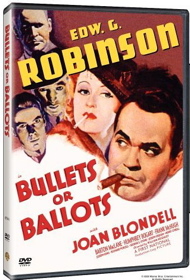
Bullets or Ballots
1936 / 82 min. /
Starring Edward G. Robinson, Joan Blondell, Barton MacLane, Humphrey Bogart, Frank McHugh
Cinematography Hal Mohr
Art Direction Carl Jules Weyl
Film Editor Jack Killifer
Written by Seton I. Miller, Martin Mooney
Produced by Louis F. Edelman
Directed by William Keighley
The klunky title Bullets or Ballots substitutes another gangster-like tough guy hero for the forbidden gangster character. Edward G. Robinson's disgruntled police inspector goes undercover to bust an organized crime syndicate in New York. Seton I. Miller is again responsible for the no-nonsense screenplay. Barton MacLane has an even bigger role as the main bad guy, backed by a new villain in the Warner 'hood: Humphrey Bogart.
It's all a ploy for Johnny to learn the identities of the elite Cabal behind Kruger's little empire, but will Blake live long enough to make his undercover assignment pay off?
Ah yes, the undercover cop story ... which has probably been around since 1915. Bullets or Ballots purports to be an exposé of how the vice rackets really operate, and it's fairly credible up to a point. In this film New York appears to be sewn up by the hoods, so much so that honest officials have to bring in a special police chief with special powers to have any effect. This new cop answers to no one and doesn't have to detail his methods, so he's really sort of a paid warlord. His secret ploy is to infiltrate the mob and destroy it from within.
We get a good look at illicit rackets that operate complex money-laundering factories hidden in remote buildings, and keep no records so that investigators can't "follow the money". Illegal bets and the eventual numbers game are all cash businesses. Individual bosses run the rackets, organized under a kingpin, Barton MacLane's dour Kruger character. Humphrey Bogart's hothead Fenner blows everything by indulging a penchant for violence that Kruger says is old-time stuff. Interestingly, the script is mature enough to show that Kruger is in kind of a tight spot, existentially speaking. Kruger answers to a few 'Mr. Bigs' that only he knows. It may be great to be the top man, but it's the last job anyone has. Kingpins don't retire; they're eliminated when the Mr. Bigs want somebody new in place.
Robinson's stubborn Johnny Blake is somewhat reminiscent of his character Keyes in Billy Wilder's later Double Indemnity -- beneath his crook act he's as tenacious as a bulldog. He even puts his favorite girl out of the Numbers business, in a move predicting Abraham Polonsky's Force of Evil. Blake goads the loose cannon Fenner into making some stupid mistakes that allow the undercover cop to discover who's behind the mobs.
The answer to that question uncovers the essential dishonesty of almost all early crime pictures. The big bad guys turn out to be three fat-cat bankers, otherwise upstanding citizens raking off millions in racketeering profits. Bankers were a rather easy target choice, as the public was eager to blame them for all of the ills of the Depression. The deception was necessary to avoid putting messages into Bullets or Ballots that would appear subversive, anti-American or Pinko. The truth could not be spoken: That million dollar organized crime rackets operated without risk because the nation's police forces and politicians were in for a cut of the action. There were plenty of honest cops who literally ended up directing traffic because they wouldn't play the game. Serpico- like scenarios probably played out yearly from the time of the Tammany Hall scandals in the 1800s.
In other words, the movies couldn't be upfront about the fact that America was being undermined by organized crime, because the truth would hurt our pride and maybe affect Wall Street. So Johnny Blake finds a few greedy bankers at the end of the trail, not the whole Mayor's office, or a phone line to The Syndicate or the Mafia. if Bullets or Ballots were truthful, the ending would find New York completely purged of organized criminals, right?
Edward G. Robinson is terrific, a really interesting actor and not one we'd think audiences would want to look at for eighty straight minutes. Everybody else is effective but off to the sides. Bogart already shows his detached sense of Cool, an attitude that definitely represents the future of tough-guy acting. In a nice touch, Joan Blondell's Lee has assigned the Harlem Numbers territory to her ex-hairdresser Nellie La Fleur, a black woman (Louise Beavers). Only Warners would put a black actor in such a role -- even if Nellie says she'd really like to "go back to fixin' " the white lady's hair.
(spoiler)Just desserts are dished out freely in Bullets or Ballots. Every bad guy bites the dust to atone for the almost complete criminality on display. We get the feeling that even Eddie Robinson's character has to pay too, just for pretending to be a bad guy; if that's the case, the keepers of the Production Code were even creepier zealots than we thought.
Bullets or Ballots has another similar call-sheet of goodies. The Warners Night at the Movies lineup is another newsreel, a musical short with George Hall's orchestra, and another weird cartoon called I'm a Big Shot Now. The new featurette Gangsters: The Immigrant's Hero points to the probability that this box was originally to be a "Gangster Collection Volume 2." Another golf show is balanced by a radio show with Eddie Robinson, Humphrey Bogart and Mary Astor. If I were you I'd go straight for the blooper reel, Breakdowns of 1936. Those things always have a fun surprise or two.
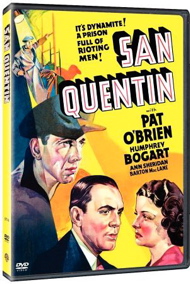
San Quentin
1937 / 70 min. /
Starring Pat O'Brien, Humphrey Bogart, Ann Sheridan, Barton MacLane, Joe Sawyer
Cinematography Sid Hickox
Art Direction Esdras Hartley
Film Editor William Holmes
Written by John Bright, Humphrey Cobb, Peter Milne, Robert Tasker
Produced by Hal B. Wallis, Jack L. Warner
Directed by Lloyd Bacon
They can't all be gems, and San Quentin gets my vote for the snooze title in this particular boxed set. It's strictly for Humphrey Bogart and Ann Sheridan fans, and I guess for devotees of Pat O'Brien. Ms. Sheridan is mostly wasted and Bogart gets yet another chance to play an uninteresting thug who (sniff) tries to go straight but finds that atonement comes at a high price. With only a couple of exceptions he'd be doing this same schtick until 1940's High Sierra lifted him skyward.
San Quentin is only seventy minutes long and it looks like several scenes were deleted before release, for unknown reasons. What remains is barely a movie. The four writers' work may have been simplified somewhere along the way, but the picture is at a loss for action. A nightclub meeting (with a song, naturally) turns into an underdeveloped romance. O'Brien's Steve remains sympathetic as he takes his new job seriously and inspires the inmates with his integrity. Sheridan's May is unreasonably harsh toward Steve, when all the real trouble in the prison is being caused by a rotten passed-over lieutenant guard played by --- surprise! --- Barton MacLane. MacLane has instigated a reign of unfair punishments. The beatings and cruelty inspire a breakout, but Red eventually realizes how good an egg Steve is, and in the sentimental finish tries to make it up to him, proving that movie convicts are really stand-up guys.
That's it. There are no surprises and no character interest beyond the main motivations. Sheridan is a loving girlfriend one minute and hostile the next, as the script demands, and we don't believe a bit of it. O'Brien makes with the sub-Spencer Tracy soulful looks but is mostly a drag. Bogart again shows glimmerings of future promise, but it's as if the movies had to evolve before they'd be good enough for him. We're happy Warners found it useful to let Bogie hang around; evidently his Petrified Forest reputation and a certain popularity squaring off again and again with James Cagney kept him on the plus side of the ledger.
The production isn't any thrill either. Warners' prison block and prison yard sets get a workout, as does the lot's machine shop, which had to do double duty as the San Quentin workshop. I wonder if studio carpenters worked the machine tools and got extra pay, or if they just told numbskull extras to risk their fingers working the band saws.
Of the supporting cast, we immediately recognize Joe Sawyer, Veda Ann Borg and Marc Lawrence; it isn't like they have much of anything memorable to do.
The transfer of San Quentin looks fine. The location footage matches well, although almost every time we cut back to the establishing prison shot, the same car is waiting near the gates, even if the shots are supposed to be days or weeks apart. The commentary is by film Historian Patricia King Hanson, who does an exemplary job finding appropriate things to say about San Quentin, along with her own fair share of story-explaining. Ms. Hanson works on the AFI's film catalogues and is scrupulously accurate with her information. Savant (ulp) is well aware of the kinds of goofs that can sneak into "expert" commentaries.
The Warner Night at the Movies this time offers the studio's Technicolor short adaptation of Edward Everett Hale's Man Without a Country, which I remember seeing a battered print of in High School. John Litel and Gloria Holden star. Porky's Double Trouble is a wacko Frank Tashlin cartoon with a prison breakout theme.
In the regular menu we've got a new featurette on "Big House" movies and the Breakdowns of 1937 blooper reel. The run-of the mill blown lines (remember Warners' obsession with getting complicated dialogue read fast and sharp) aren't as funny as the occasional aside or crack up ... and as the decade goes on, the kinds of frustrated oaths uttered are starting to get more ribald!
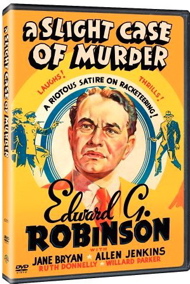
A Slight Case of Murder
1938 / 85 min. /
Starring Edward G. Robinson, Jane Bryan, Allen Jenkins, Ruth Donnelly, Willard Parker, John Litel, Edward Brophy, Harold Huber, Paul Harvey, Bobby Jordan
Cinematography Sid Hickox
Art Direction Max Parker
Film Editor James Gibbon
Written by Earl Baldwin, Joseph Schrank from a play by Damon Runyon, Howard Lindsay
Produced by Samuel Bischoff
Directed by Lloyd Bacon
A Slight Case of Murder shows what Warner could do when attempting a screwball comedy twist on the gangster movie. The results are uneven but there are indeed some big laughs to be found; whether your mileage is better than Savant's will depend on individual taste.
Individual taste is indeed the key to A Slight Case of Murder; the funniest scene is when Eddie Robinson and his cohorts finally try to drink some of their fabulous brew. We get to see mugs like Allen Jenkins and Edward Brophy making faces like they're going to throw up, or maybe explode. Robinson's mugging is great too -- it's a funny scene.
The rest of the tale throws together as many wacky elements as possible. A nasty rival killer plays hide 'n seek after killing four of his own buddies. Remy tries to reform an incorrigibly rotten orphan (Bobby Jordan). Mrs. Marco (Ruth Donnelly) has a bad habit of letting her rough language leak through her high society act. At his all-lowlife party, Marco doesn't realize that one of his guests is the head legal representative for the state, and that he'll soon bump into the perforated stiffs in the upstairs closet.
Like many Warners' late-30s comedies (perhaps Savant has just seen the bad ones) A Slight Case of Murder works too hard for its effects and is haphazardly constructed. A big side plot is the daughter's bid to get dad to accept her beau. She just disappears from the storyline, as if simply overlooked. The fun is watching the various character actors interact, especially Robinson's funny mugs ... and that great beer tasting scene. 1
Warners made a few more Robinson crime comedies directed by Lloyd Bacon but I've only seen Brother Orchid, which I remember being much funnier than this one. On the other hand, I was probably 14 when I saw it.
Warners' DVD of A Slight Case of Murder looks and sounds fine, like all the others in this set. Noted historian Robert Sklar provides the commentary this time and he's dependably informative and easy to listen to.
The Warner Night at the Movies extras are a Technicolor costume show about The Declaration of Independence and an almost surreal cartoon called The Night Watchman in which a sick cat's kitten is given the job of policing a kitchen full of tough-guy rats, who proceed to rough him up. The new featurette concentrates on the story of prohibition. There's no Breakdowns gag reel; I think it may have been used on the Adventures of Robin Hood disc.
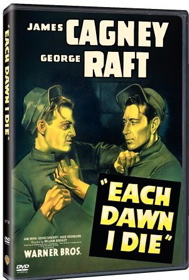
Each Dawn I Die
1939 / 92 min. /
Starring James Cagney, George Raft, Jane Bryan, George Bancroft.
Cinematography Arthur Edeson
Art Direction Max Parker
Film Editor Thomas Richards
Original Music Max Steiner
Written by Warren Duff, Norman Reilly Raine from a novel by Jerome Odlum
Produced by David Lewis
Directed by William Keighley
Prison fun time recovers somewhat in Each Dawn I Die, a generic "I wuz framed!" tale lifted to new heights by James Cagney's sterling performance. The story is at least five or six years behind the times but Cagney gives it maximum energy, dragging the dead weight of George Raft behind him. The basics of great genre acting can be seen right here by comparing Cagney and Raft's presence. Both are handed the same re-fried cliché's. Cagney animates everything he's given while Raft slogs through like a dullard, letting his good looks and street reputation do the acting for him.
James Cagney approaches his rogue reporter role the way he did his gangsters and his "G"-Man: With a cocky grin and a sharp tongue. But we see him change into a bitter jailbird under torture, perhaps to become the psychotic criminal that "the system" seemingly wants him to be. Thus we see the full gamut of expert Cagney attitudes. The crooked parole board is only acting on objective information, but it seems incredibly corrupt when Cagney breaks down in tears, begging to be let free. The guards torture Frank Ross by handcuffing him in a standing position for hours in a darkened solitary cell. They corner the helpless Frank in an empty office with Billy clubs. This is rough stuff; almost as bad as Junior High School.
Warners was known as the liberal, working man's studio, which was certainly true for its pre-code pictures and the occasional socially themed movie. And it's true that Paramount or MGM just wouldn't put out a picture that hints that there are major flaws in or police force, the political arena or our prisons. Each Dawn I Die ends up placing the blame on some rotten-egg prison guards and a pair of cardboard politicos, but at least it acknowledges that there are problems. An MGM movie would probably whitewash the authorities, blame the prisoners for not attending Spencer Tracy's church services on a regular basis, and be done with it.
Each Dawn I Die had the exploitable hook of Cagney facing off with George Raft, and an alternate title was apparently Killer Meets Killer. Co-star Raft is now most notable as an actor who consorted with real crooks before and after stardom, including maniacs like Bugsy Siegel. Most of his starring vehicles aren't shown much any more and he's most famous for the roles he turned down because they weren't "moral" enough. Humphrey Bogart practically owes his career to the fact that Raft ixnayed the leads in career-making pictures like High Sierra and Casablanca. Raft's scenes are weak, especially when he's supposed to be running a mob out of a hotel room, and Jane Bryan's heroine has to inspire him to make good on his promise to Frank. It's no more silly than the plot reversals Cagney is put through, but Cagney would have made us believe them 100%.
Generic prison pix required almost nothing in special production outlays, which is a big reason they've always been popular with studios trying to pinch a penny. Arthur Edeson's handsome photography helps out; scenes aren't strongly stylized but we also aren't distracted by a lot of expressionist touches. This is an old-fashioned Warners' thriller that delivers the goods, even if we already know that our hero will be vindicated before the curtain goes down.
Each Dawn I Die has a strong performance by George Bancroft, finally being allowed to play a relatively good guy opposite Cagney. Victor Jory is the odious fat-cat villain. "Slapsy Maxie" Rosenbloom is a featured inmate, while Stanley Ridges (Black Friday) is a freaked-out con and Louis Jan Heydt a sick one. Abner Biberman gives us another of his unforgivably craven bad guys.
Warner Home Video continues packing the goodies onto these Tough Guy pictures. Guest commentator this time is film historian Haden Guest, who does a good job of placing the particulars of Each Dawn I Die into their proper perspective. The Warner Night at the Movies selection includes a Technicolor look at the Santa Anita raceway and the 'travelogue' themed Tex Avery cartoon Detouring America. It comes complete with a disclaimer for its racial stereotypes, but finishes with a copyright notice that says it has been re-dubbed. I wonder what for -- perhaps a snippet of expensive-to-license music?
The new featurette examines the lexicon of gangster films and is entitled Stool Pigeons and Pine Overcoats. Younger audiences probably need to have a lot of the old slang -- itself sometimes altered from more uncouth real slang -- explained to them. A radio show with George Raft and Franchot Tone is also offered, along with a really funny Elmer Fudd cartoon, Each Dawn I Crow. The Breakdowns of 1939 blooper reel has some equally funny cutups, like Bette Davis in Juarez ending a failed take by saying that she can't turn her head without pulling her wig off.
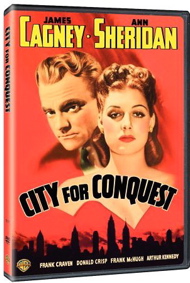
City for Conquest
1940 / 101 min. /
Starring James Cagney, Ann Sheridan, Frank Craven, Donald Crisp, Anthony Quinn, Frank McHugh, Arthur Kennedy, George Tobias, Jerome Cowan, Elia Kazan
Cinematography James Wong Howe, Sol Polito
Art Direction Robert Haas
Film Editor William Holmes
Original Music Max Steiner
Written by John Wexley from a novel by Aben Kandel
Produced by William Cagney, Anatole Litvak, Hal B. Wallis
Directed by Anatole Litvak
Savant's personal favorite in the Tough Guy Collection is City for Conquest, even though it's not the best of the bunch. Savant's frequent correspondent 'B' has even written in to let me know that if I'd just consulted the New York Times Movie Reviews book, I'd have seen Bosley Crowther's initial assessment of Frank Craven's 'missing' scenes, thereby sparing me the suspense of waiting for the disc. But that was part of the fun. "G-Men" and Bullets or Ballots are top pictures and the other three less spectacular, but fans wanting to see Edward G. Robinson, James Cagney and Humphrey Bogart in out-of-the ordinary roles will be pleased. Confidentially, Savant can't wait for a James Cagney box of his early pre-code work like Picture Snatcher, or the beginnings of a Pre-Code Naughtiness set starting with the newly restored Baby Face. I hope the Shield in Burbank keeps them coming.
On a scale of Excellent, Good, Fair, and Poor,
|
G Men rates:
Movie: Excellent Video: Excellent Sound: Excellent Supplements: Warner Night at the Movies 1935: vintage newsreel, comedy short The Old Grey Mayor starring Bob Hope, classic cartoon Buddy the Gee Man. New featurette Morality and the Code: A How-to Manual for Hollywood; Commentary by film historian Richard Jewell; How I Play Golf by Bobby Jones No 11: Practice Shots; Things You Never See on the Screen: Breakdowns of 1935 studio blooper reel; Trailer |
Bullets or Ballots rates:
Movie: Excellent Video: Excellent Sound: Excellent Supplements: Warner Night at the Movies 1936 short subjects gallery: vintage newsreel, musical short George Hall and His Orchestra, classic cartoon I'm a Big Shot Now. New featurette Gangsters: The Immigrant's Hero; Commentary by film historian Dana Polan; How I Play Golf by Bobby Jones No. 10: Trouble Shots; Breakdowns of 1936 studio blooper reel; Audio only bonus: 4/16/1939 Lux Radio Theater Broadcast with Edward G. Robinson and Humphrey Bogart; Trailer |
|
San Quentin rates:
Movie: Fair Video: Excellent Sound: Excellent Supplements: Warner Night at the Movies 1937 short subjects gallery: vintage newsreel, Oscar-nominated Broadway Brevity short The Man Without a Country, classic cartoon Porky's Double Trouble. New featurette Welcome to the Big House; Commentary by film historian Patricia King Hanson; Breakdowns of 1937 studio blooper reel; Trailer |
A Slight Case of Murder rates:
Movie: Good Video: Excellent Sound: Excellent Supplements: Warner Night at the Movies 1938: vintage newsreel, Oscar-nominated drama short Declaration of Independence, classic cartoon The Night Watchman. New featurette Prohibition Opens the Floodgates; Commentary by film historian Robert Sklar; Theatrical trailer |
|
Each Dawn I Die rates:
Movie: Very Good Video: Excellent Sound: Excellent Supplements: Warner Night at the Movies 1939 short subjects gallery: vintage newsreel, documentary short A Day at Santa Anita, Oscar-nominated classic cartoon Detouring America. New featurette Stool Pigeons and Pine Overcoats: The Language of Gangster Films; Commentary by film historian Haden Guest; Breakdowns of 1939: studio blooper reel; Bonus cartoon Each Dawn I Crow; 3/22/43 Lux Radio Theater Broadcast with George Raft and Franchot Tone; Trailer |
City for Conquest rates:
Movie: Excellent Video: Excellent Sound: Excellent Supplements: Warner Night at the Movies 1940: Vintage newsreel, Oscar-nominated short Service with the Colors, classic cartoon Stage Fright. New featurette Molls and Dolls: The Women of Gangster Films; Breakdowns of 1940: studio blooper reel; Audio-only Bonus: 2/9/1942 Lux Radio Theater Broadcast; Commentary by Richard Schickel; Trailer |
Reviewed: July 6, 2006
Footnote:
1. I can hear invisible voices saying "What, is this guy nuts?" Of course Warners makes funny films, but the all-out comedies I've seen (from the middle-late 30s) don't hold up the same way Paramount and Universal's fare does. Boy Meets Girl is very good, but the others I've seen seemed forced. On the other hand, the level of humor they jam into dramas and genre work is high, especially with talent like Glenda Farrell and Joan Blondell helping out. I suppose the suicidal angle in this statement is the "that I've seen" part ... and this is a cry for help or something. But I'm not counting early 30s musicals or pre-code pictures.
Return
|
|
Reviews on the Savant main site have additional credits information and are more likely to be updated and annotated with reader input.
Review Staff | About DVD Talk | Newsletter Subscribe | Join DVD Talk Forum
Copyright © DVDTalk.com All rights reserved | Privacy Policy | Terms of Use
|
| Release List | Reviews | Price Search | Shop | SUBSCRIBE | Forum | DVD Giveaways | Blu-Ray/ HD DVD | Advertise |





